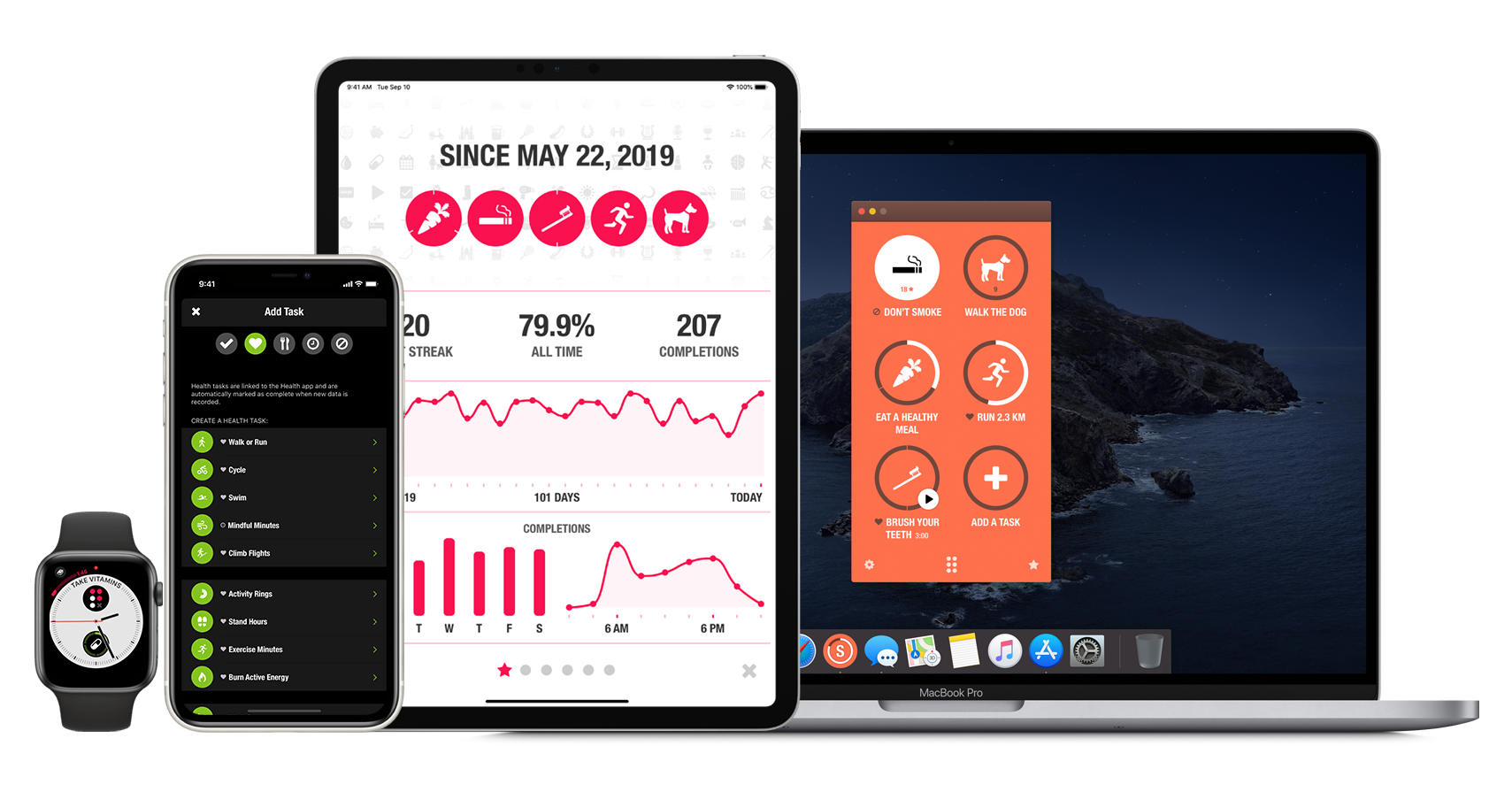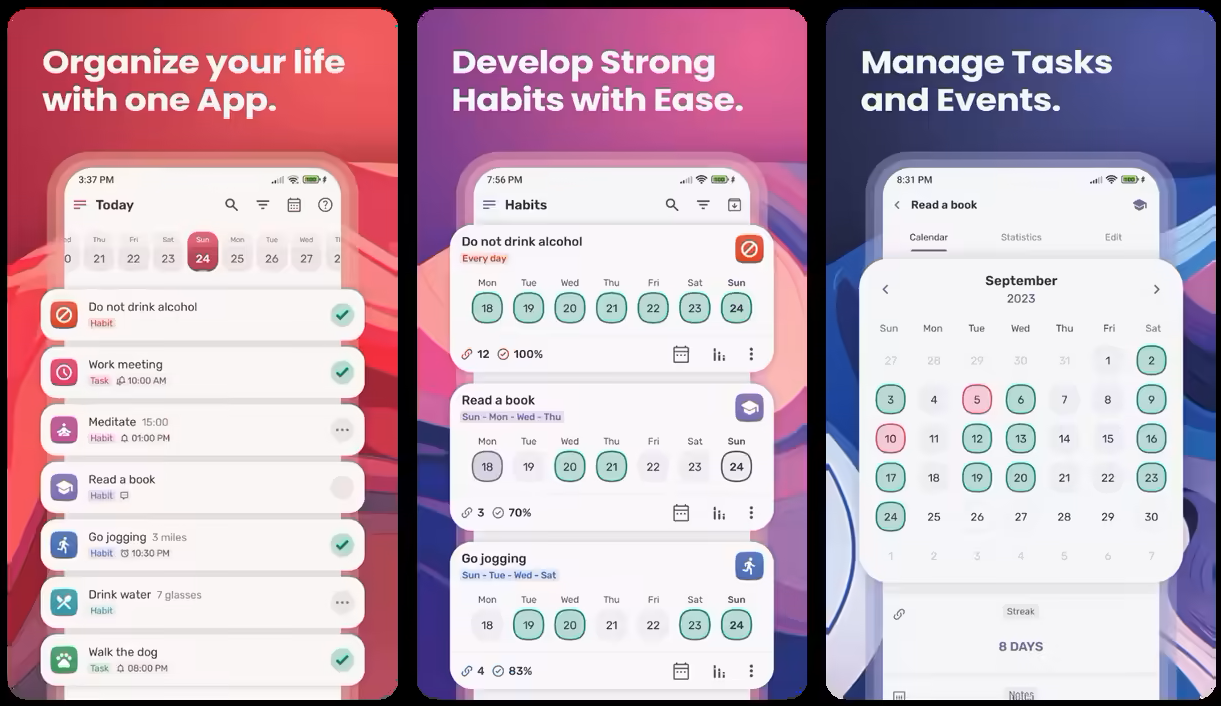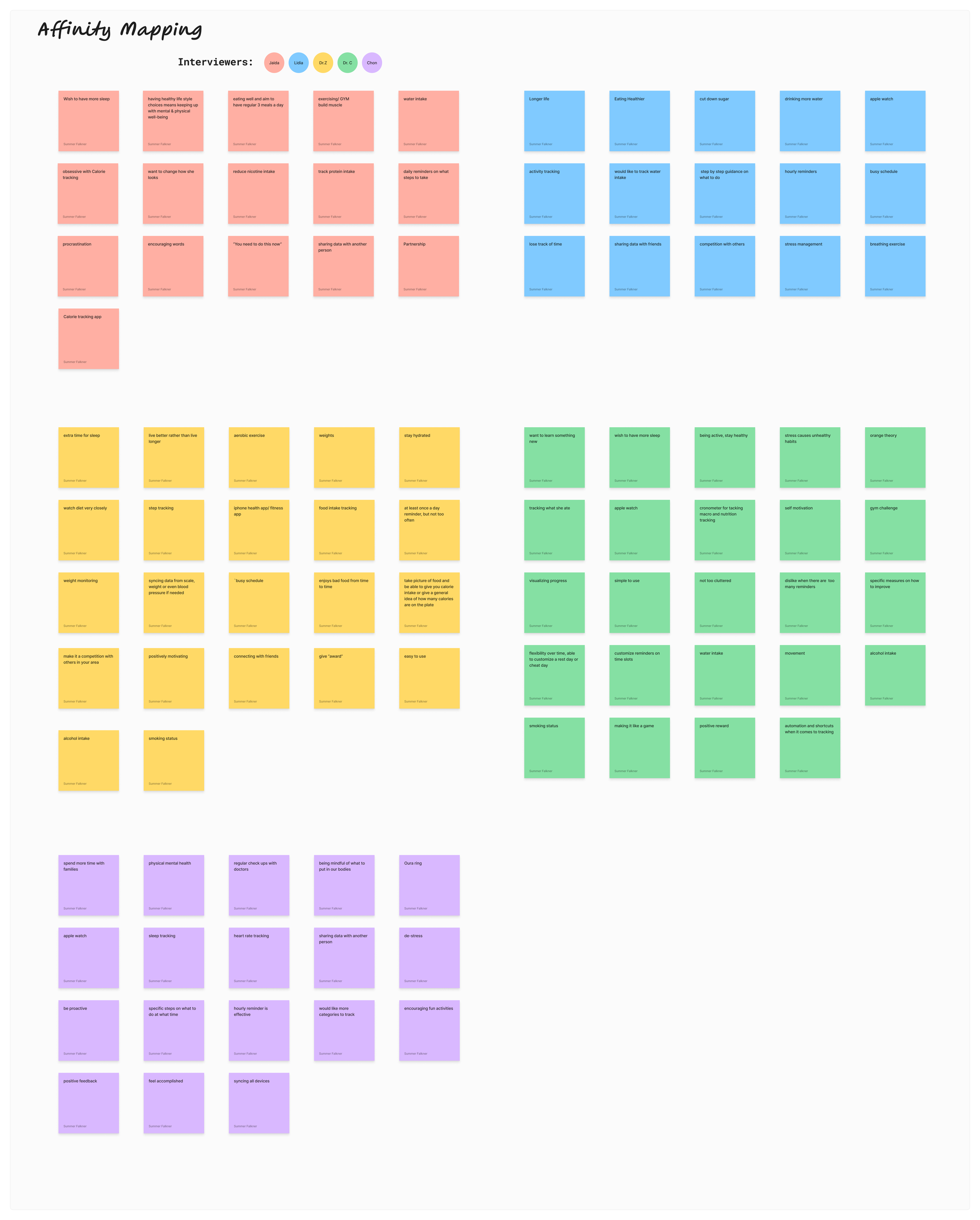Product type:
Responsive Web Design
10 weeks / 100 + hours
Role:
Sole researcher & Designer
Tools:
Figma
Otto.ai
Optimal Workshop
Contributions:
User Interviews
Define
Ideation
Wireframe
Prototyping User Testing
Iteration
Research
Problem
People wouldn’t know how to improve their daily health without a proper way of tracking their habits such as sleep, water intake, stress management, healthy diet, physical activities and alcohol intake. They also need guidance on what exact measures to take daily in order to better their physical, mental, and emotional well-being.
Background
It is crucial to be proactive about our health and take steps to prevent illness and disease. Other than doing our routine check up with our primary care physicians, dentists and other specialists, healthy lifestyle choices should be our priority. Most of us have no idea where to start without knowing what they have been doing in the past and personalized steps on how to improve.
Research Goal
To learn what current habits users have so that we can provide personalized guidance on how to improve to reach their overall health goal.
1.Competitive analysis
StreaksUser Interviews
Affinity Mapping
Insights:
Motivation & Goal Clarity
- Users struggle with setting specific, actionable goals.
Ease of Tracking & Habit Formation
- Tracking can feel tedious or complicated
Consistency & Accountability
- Users struggle to stay consistent, especially after missing a day.
Personalized Guidance & Feedback
- Users want advice tailored to their progress.
Gamification & Motivation
- Gamified elements like badges and challenges increase engagement.
Mythologies
2. User Interviews
3. Affinity Mapping
Comparative Analysis
HabitNowHabitifyI compared 3 other most used habit tracking app/services out on the market to analyze theirs strength, weaknesses, features and pricings. Through this competitive analysis I discovered what are some of the must haves in order for people to track their habits as well as what I could include in my design which other competitors are lacking.
-
Target Market: iPhone Users
Pricing: $4.99 for the universal app
Strengths:
A great Apple-focused habit tracking app
Super fast and easy to use
Shows overview of all Users’ streaks
Weaknesses:
The design might not be for everyone
Streaks heavily relies on synchronization with iCloud, which may pose challenges for users in areas with limited or no internet connectivity.
They’re informative but lack interactivity; users can’t complete tasks directly from the widget.
-
Target Market: Android users
Pricing: Free habit tracker app for up to 7 habits; $9.99 for Premium with unlimited habit tracking.
Strengths:
A really great Android habit tracking app
Free plan is sufficient for most people
Add recurring tasks (which aren't tracked) and single tasks (one-off to-dos)
Weaknesses:
Built-in task tracking is pretty basic
Cannot setup recurring weekly tasks (tasks you need to complete once a week)
No automation, must log all details manually
-
Target Market: iOS, macOS, Android, and the web users
Pricing: Free for 15 check-ins per week; from $4.99/month for Premium with unlimited habit check-ins
Strengths:
One of the best cross-platform habit tracking apps around
Integration with other apps allows for automatic habit tracking
Create user “Priority” Area to always keep them focus on what's important.
Weaknesses:
Subscription price is very expensive for a habit tracking app
To track a habit you want to perform more than once a day, you have to create separate habits.
That uses up your habit allotment in the free version, and you can’t visualize the data as one habit.
The overall completion rate is not useful because some of users habits are by the times per week
User Interviews were conducted to gain insight into the experiences and challenges faced by habit trackers when tracking their daily habits in order to improve their lifestyle.
Research Objectives
Determine how do users track their habits if at all.
Understand what having better lifestyle choices mean to users.
Understand what kind of feedback users would like to get in order to improve their health.
Learn what are the main categories of habits users would want to change.
User Interview Pain Points:
Habit tracking apps/ services not providing guidance on what specific steps to take in order to improve users’ health or reach their daily goals.
Busy schedules/ stress level (mood) stop people from remembering to keep up with their healthy lifestyle choices.
Habit tracking apps/ services on the market now don’t seem to have every category users might want to track.
People are not getting enough motivation/ rewards from current tracking devices they use.
Reminders are great to have but when it goes off at the wrong time or when it happens too often, people tend to start ignoring them.
User Interview Needs:
People need a habit tracking app/ service that can group all the main categories they would like to track in one place.
People need proper feedback on how to improve their lifestyle choice with the exact steps/ measures to take.
People need to be able to customize what kind of reminders they want, how often they want them and when they will get notified.
People need an easier way to sync all data from their phone, watches/ fitbits, and other apps into one place in order to see their overall progress.
People need something easy to use without too much clutter to make their eyes/minds tired.
After conducting the interviews, I organized my findings from the user interviews into an affinity map with 6 different categories to identify insights and patterns.
Social Features & Community
- Users enjoy connecting with others who share similar goals.
Avoiding Overwhelm & Burnout
- Users feel overwhelmed by too many habits or goals.
Context Flexibility
- Users face barriers like travel, stress, or illness.
User Experience (UX) Preferences
- Users prefer simple, intuitive designs and customizable features.
Define
The competitive analysis and user interviews helped me gain a clearer picture of the users and how they might use a habit tracking app. I used these insights to create visual representations that not only deepened my empathy for the users but also informed the direction of the product.
User Persona
Understanding the user perspective, we created the personas (Chloe & David) to help us move forward with our decision-making.
POV/ HMW
I’d like to explore ways to help habit tracking users to stay motivated and feel accomplished when it comes to bettering their lifestyle choices because busy schedules can always get in the way as well as being able to enjoy a rest day or cheat meal without feeling guilty.
How might we help habit tracking users to stay motivated and feel accomplished when their busy schedules get in the way or if they decide to enjoy a rest or cheat meal?
Solution: Tracking their daily habits with reminders to help users reach their daily, weekly or monthly goal.I’d like to explore ways to help habit tracking users with receiving guidance on what specific steps to take in order to improve because they are not getting proper feedback from the habit tracking apps/services they are using currently.
How might we provide habit tracking users the proper guidance in order to improve their lifestyle choices ?Solution: Guidance provided after habit tracking based on users’ age and gender.I’d like to explore ways to help habit tracking users to be able to customize how often they are reminded to reach their over all goals because they all have different preferences and have different schedules when it comes to sticking to their health journeys.
How might we help habit tracking users to customize reminders in order to reach their health journey goals given their own preferences and busy agenda?Solution: Being able to set however many reminders and customize the time.
Ideation
Task Flow
Sitemap
This sitemap structure outlines the user flow from registration to habit tracking and management, focusing on the app's essential features and navigation.
User Flow
User’s primary path within BasicSkin.ai includes signing up/ signing in, setting up account for new users, creating new habit, tracking habit, and receiving personalized guidance to reach their over all health goal.
Prototype & Testing
Usability Testing Summary
Tasks
Sign up & create an account in order to improve their over all health through bettering their lifestyle choices.
Create a new habit from the start whether it’s a pre set option or to customize their own habit.
Track the habit they just created and see how far they are from their daily goal. Receive useful guidance and tips on how they can actually improve.
Metrics
Success/Failure rate of completing tasks: 6/7 participants completed each task.
Level of difficulty of completing tasks: 7/7 participants found the tasks straightforward and easy.
Total time of task completion: 7/7 participants completed each task in less than 3 minutes.
High-priority
Adding the track habit page so the flow makes more sense for users.
Providing the options page so users know where to go to either track to receive guidance from the specific habit.
Adding hidden menu by each habit to suggest further action.
Adding prototype interactions for users to go back to the previous page or undo last action.
Low-priority
Making the over all design bigger. (Only one user mention something about this and she was the oldest, the iPhone screen prototype was a little small for her to see)
Adding apple email sign up flow in the prototype.
Adding other habit’s guidance page/ tracking page.
Conclusion
The key takeaway is the importance of personalization and user empowerment. By integrating tailored guidance and actionable feedback based on users' unique progress and behaviors, the app not only helps users track their habits but also motivates and supports them on their individual journeys. The ability to adjust goals, receive custom advice, and track progress with flexibility has proven essential in keeping users engaged and committed.
The most significant learning lesson from this project is that habit-building is not a one-size-fits-all process. Every user has different motivations, challenges, and preferences. While some users thrive with gamification and external rewards, others prefer a more minimalist approach with subtle nudges. The app needs to be flexible enough to cater to different needs and be adaptive over time, adjusting the level of guidance or complexity as users progress.














